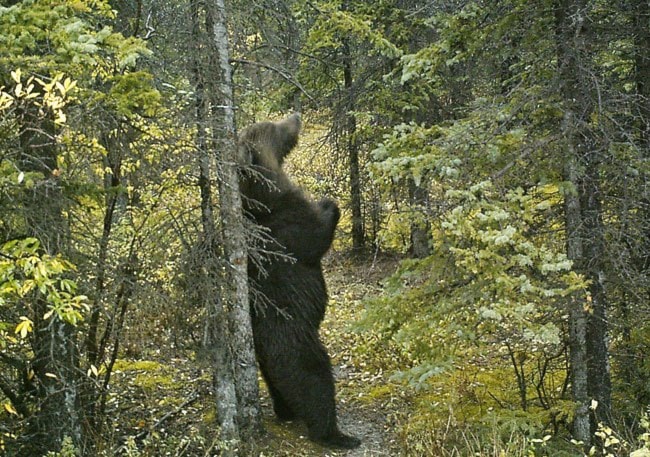by Erling Friis-Baastad
Each summer and autumn, we’re reminded that we share this land with grizzlies and black bears. Sometimes the bears and sometimes the people are not gracious about this. Problem bears? Problem humans? Depends on whose paws you were born into. Most of us seem to be both terrified and thrilled by the beautiful creatures Ursus horribilis and Ursus americanus.
Campgrounds are among the places where bear wishes and human wishes collide, and where wilderness-loving people seem to want it both ways - exhilarating and safe. That puts tremendous pressure on conservation officers and parks staff.
Historically wildlife managers have sometimes been too quick to employ less-than-effective strategies, says Yukon College Renewable Resources Management program instructor Scott Gilbert. He and his students are trying to manipulate bear habitat as an alternative to lethal force and relocation.
Gilbert, with some strong-backed college students and a crew from the Yukon Environment’s Y2C2 program, has been toiling in Congdon Creek campground over the past two summers to find ways of reducing these cross-species conflicts and the subsequent calls for drastic action. The campground sits just south of Destruction Bay and in a convenient spot for Alaska Highway travellers. Grizzlies enjoy the area too.
Another major player in the Congdon Creek campground drama is Shepherdia canadensis, the soapberry. Soapberries have a bitter taste. This is fine with bears - so fine that Gilbert suspected that removing the berry shrubs - or at least the females, which produce the berries - could cut down on ursine traffic in an area.
Gilbert’s first step in studying bear problems and possible solutions at Congdon Creek was to undertake historical research. He peered back through other people’s memories of the area since the park opened in 1976: parks staff, conservation officers, First Nation wildlife monitors, highway crews. All contributed knowledge, in print or orally. So did Yukon Archives, Yukon Environment library and the Energy, Mines and Resources library.
After all that searching, Gilbert was unable to find any information that could provide a rationale for choosing Congdon Creek for a campground, as he admits in History of Human-Bear Interactions at Congdon Creek Campground. “Nor could I find any preliminary assessment of the anticipated impacts of using high quality grizzly bear habitat for a campground,” he adds.
One result was that partial campground closures were imposed at the height of the berry season. This meant that hard-sided RVs could park there overnight, but small-footprint, and more vulnerable, tenters were not allowed. “The bear occurrence reports for the Congdon Creek area show that of 21 reports attributed to the campground, 24 per cent ... involved reports of bears disturbing tents,” Gilbert writes.
As if natural goodies weren’t problem enough, another attractant was added to the area in the 1970s: “a trench and burn” landfill. “Several of the workers I interviewed who were involved with the Congdon Creek campground in the 1980s mentioned that the bears that frequently visited this landfill ... likely also visited the nearby campground,” writes Gilbert.
Meanwhile campground garbage went into receptacles fashioned from 45- gallon drums “with a metal top removed and replaced with a wooden cover to prevent wind and small animals from spreading litter.” By the late 1980s and early ‘90s, bear-proof containers were finally being deployed in the territory’s parks and at rest stops. But all in all, a bear could hardly be faulted for crossing our many confusing lines in the sand.
So garbage cans were re-engineered and the landfill moved, but the soapberries continued to thrive at Congdon Creek. “Most berry-producing plants use sugar (carbohydrates) to attract foragers to help disperse their seeds because nitrogen needed to make proteins is in short supply,” Gilbert explains.
However, “soapberry bushes seem to differ,” he adds. They have root nodules where bacteria assist the plant by converting nitrogen for plant use. With ample nitrogen the plants produce high levels of protein. Vive la difference! ... at least as far as bears are concerned. Though they do eat some meat, the big creatures can fuel up just fine with proteinaceous soapberries.
Jake Montgomery, a student in Yukon College’s Renewable Resources Management program, set up an experiment last spring . He wanted to determine whether soapberry bushes could be successfully transplanted elsewhere - to a place where hungry bears were less likely to encounter campers. Perhaps the tenacious plants might even contribute to landscape remediation - at an abandoned mine site, for instance.
Meanwhile, Renewable Resources Management student Shayna Kinney gathered ripe soapberries in August to ship to a lab Outside in order to determine protein levels of in the berries at Congdon Creek and nearby.
All in all, the multifaceted, sometimes backbreaking, effort to find new solutions to old cross-species problems at Congdon Creek is a far cry from more-rapidly deployed “bear remedies” of the past. The proposed solutions are respectful of bears, humans and even plants.
The hopeful thinking is that efficient bears don’t waste precious warm-weather dining time on less-nourishing plants, says Gilbert. If high-protein fare can’t be readily enjoyed near the tenting areas, the bears will likely look elsewhere.
This column is co-ordinated by the Yukon Research Centre at Yukon College with major financial support from Environment Yukon and Yukon College. The articles are archived at www.yukoncollege.yk.ca/research/publications/your_yukon
